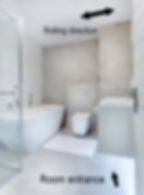How to paint a celling without roller marks?
- arochette8
- May 10, 2021
- 3 min read

Painting a ceiling is probably the most complex task you are going to do in your home when it comes to painting. Why? Because a bad application can leave roller marks, and that can be frustrating. In this article, we’ll give you all the tips you need to follow to ensure a flawless result.
1. Preparation
Like all painting jobs, preparation is key. Think about these elements before you start painting:
Prepare the surface. Fine sanding can help even out the surface and remove any residue.
Clean the surface to remove dust.
If possible, remove devices from the ceiling to facilitate work.
Remove furniture that may be in your way.
Protect the floor and the furniture in place with plastic wrap or a cotton sheet.
If necessary, place masking tape along the walls
Wear safety glasses and a hat (for obvious reasons)
2. Direction matter
The direction you are painting does matter, and is even a critical point of success if you don't want to show roller marks. Here are the factors to consider in order:

1) Where does the light come in? If your room has a window or windows, look at the direction that light is entering your room. To avoid letting roller strokes appear, you will need to paint perpendicular to the direction of the light. If your room has multiple windows in different orientations, choose the dominant direction of light relative to the position of the sun during the day.

2) From where do you enter the room? If there is no window or if there are several windows of different orientations making the entry of the light multiple, then we will opt for the direction in which we enter the room and we will have to paint, once again, perpendicularly.
3. Cutting around before rolling

Cut out all the borders before painting with your roller. This will ensure that all surfaces are covered. The roller, passing over the brush strokes, will cover them. When the cut is complete, immediately roll over.
4. Choosing the right roller for the ceiling

Looking at our chart for choosing the thickness of a roll, we see that a 15 mm (5/8“) roll is generally appreciated because it leaves a generous layer on the ceiling, which is desired. A 13 mm roller can also be used. If the ceiling is textured, a 19 mm (3/4“) roller is ideal.

Due to the type of paint that is normally used for ceilings, our 964 series is ideal. Due to the type of paint finish and density, our 964 series is designed for denser paint, with excellent absorption and release capacity.
5. Let's paint and roll

The key to a successful painted ceiling, besides the rolling direction, is to “overlap” wet paint. The air at the top of rooms is warmer, and therefore tends to dry out quickly. If we pass our roller over a section that has already started to dry, roller lines will most likely appear. It is therefore necessary to paint a relatively small area (about 4 to 6 square feet), leaving a good coat of paint. This way the sections will overlap without hassle thanks to the still wet edges.
Here are a few factors to keep in mind:
Always roll in the same direction you choose. Don't zigzags, and don't apply paint in a "W" shape like you do on walls.
Do not push on your roller, it could show traces of rollers on each side. Instead, lean for a well-loaded roll and apply evenly.
Be at a fast pace, the faster your sections overlap, the better your chances of a successful result.



